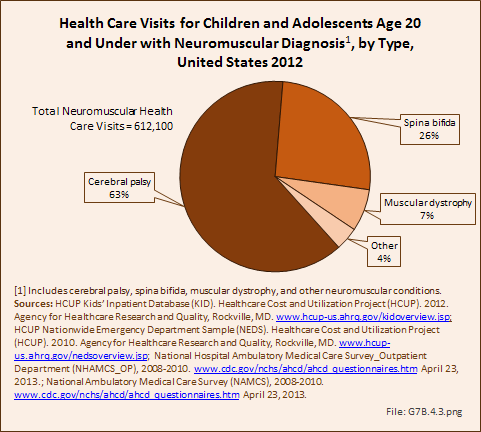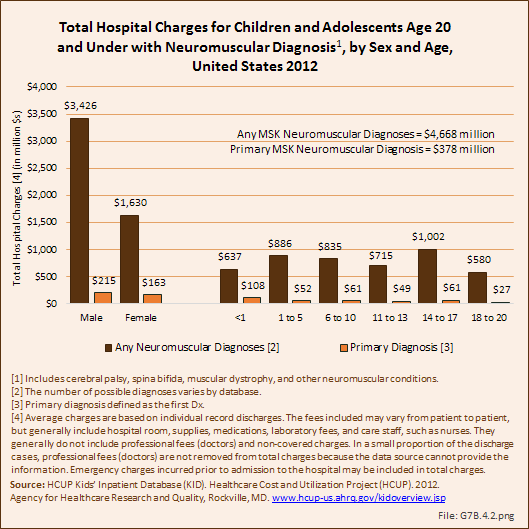

Neuromuscular conditions were diagnosed in 612,100 children and adolescent health care visits in 2012, of which 255,300 had a primary diagnosis of a neuromuscular condition. About 1 in 10 (11%) children and adolescents with any neuromuscular diagnoses were hospitalized (67,200), but fewer than 2% (4,500) with a primary neuromuscular diagnosis had a hospital discharge. (Reference Table 7.1.1 PDF [1] CSV [2] and Table 7.1.2 PDF [3] CSV [4])
Males were more likely to be hospitalized than females for both any neuromuscular diagnoses or as a primary diagnosis. Children ages 6 to 10 years had the highest rate of hospitalization, both with any diagnoses and as a primary diagnosis. Rates of hospitalization declined as children age.
Neuromuscular conditions as a primary diagnosis accounted for about 1.5% of hospitalizations for any musculoskeletal condition diagnosis and only 0.1% of all hospitalizations for any health care condition. (Reference Table 7.5 PDF [5] CSV [6])

Cerebral palsy was diagnosed in two-thirds (66%) of hospital discharges. Spina bifida and muscular dystrophy represented 18% and 8% of discharges, respectively.

Total charges averaged $69,500 for a mean 6.7-day stay when children and adolescents were hospitalized with a diagnosis of a neuromuscular condition along with other medical conditions. With a primary neuromuscular diagnosis, the stay was longer (7.5 days), and mean charges were higher at $84,000. Mean charges and length of stay were highest for the youngest patients, those under 1 year of age. Total hospital charges for all primary neuromuscular discharges in 2012 were $378 million. (Reference Table 7.5 PDF [5] CSV [6])

Links:
[1] https://bmus.latticegroup.com/docs/T7.1.1.pdf
[2] https://bmus.latticegroup.com/docs/T7.1.1.csv
[3] https://bmus.latticegroup.com/docs/T7.1.2.pdf
[4] https://bmus.latticegroup.com/docs/T7.1.2.csv
[5] https://bmus.latticegroup.com/docs/T7.5.pdf
[6] https://bmus.latticegroup.com/docs/T7.5.csv